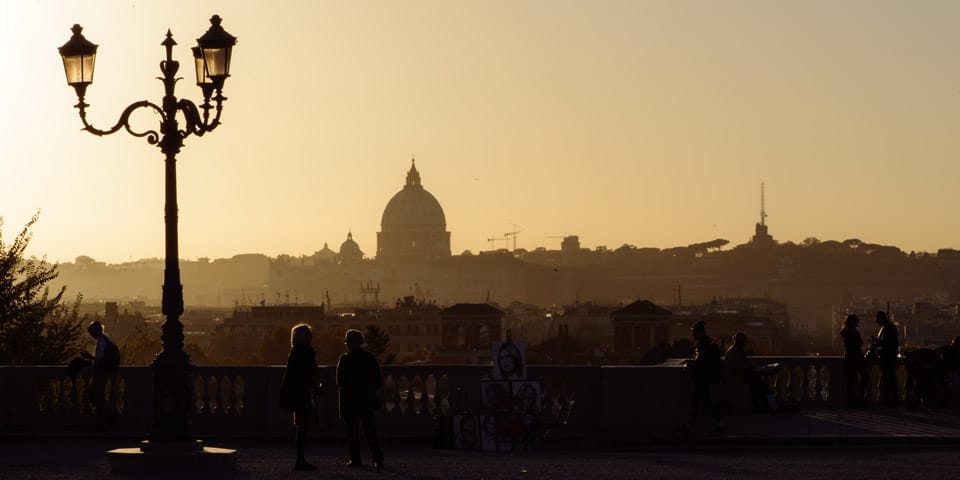

24785 views
Written by: Artur Jakucewicz

| Tip | Visit at sunset for stunning views, when the city's landmarks are bathed in golden light, creating a truly magical atmosphere. You can also see the Vatican and the dome of St. Peter's Basilica beautifully backlit. |
|---|---|
| Recommended tour | |
| Closest bus stops |
|
| Closest subway stations |
|
| Address | Piazza del Popolo, 19, Roma |
The Pincio Terrace, situated within the scenic Villa Borghese Gardens, is an elevated viewpoint offering breathtaking panoramic vistas of the city’s historic center. Perched on the Pincian Hill, the terrace provides stunning views of the iconic Piazza del Popolo, the Basilica of Santa Maria del Popolo, the Aurelian Walls, and even glimpses of the distant Vatican City.
Its lush surroundings, well-maintained pathways, fountains, and statues create an inviting atmosphere for visitors to stroll, relax, or enjoy a leisurely picnic while immersing themselves in the natural beauty of Rome and savoring the captivating sights that have made the Pincio Terrace a beloved spot for locals and tourists alike.
Contents
ToggleThe history of the Pincio Terrace in Rome dates back to ancient times. The hill on which the terrace stands, known as the Collis Hortulorum, was named the Hill of Gardens due to its lush vegetation and picturesque surroundings. In ancient Rome, it was a part of the city, and its gardens were enjoyed by residents and visitors alike.
During the Renaissance, in the 15th century, Pincian Hill was outside the city walls and belonged to the Dominican order. The hill was utilized for gardens and vineyards during this time. However, in the 19th century, the Pincio Terrace as we know it today began to take shape.
In the early 19th century, under the rule of Napoleon Bonaparte, Rome underwent significant urban planning and development. The Pincian Hill was redesigned into a public park as part of this transformation. Wide walkways, promenades, and viewpoints were added to create a pleasant and accessible space for locals and visitors.
The most significant development for the Pincio Terrace came when it became part of the Villa Borghese Gardens. The Borghese family, who owned the nearby Villa Borghese, opened up their estate to the public, creating one of the largest public parks in Rome. The Pincio Terrace became integral to this expansive green space, offering stunning panoramic views of the city and its landmarks, including the famous Piazza del Popolo.
Today, the Pincio Terrace continues to enchant visitors with its historical charm, lush greenery, and captivating vistas.
It remains a beloved destination for Romans and tourists alike, providing a serene escape amidst the bustling city and a delightful place to savor the beauty and history of Rome.
Read also about: Borghese Gallery
The Pincio Terrace in Rome offers a plethora of captivating sights for visitors to explore and enjoy. As one of the most picturesque viewpoints in the city, it provides stunning vistas of Rome’s iconic landmarks and natural beauty.
The main attraction of the terrace is undoubtedly its breathtaking panoramic views. From this elevated vantage point, visitors can gaze out over the sprawling cityscape, taking in the grandeur of Rome’s historic center. The view encompasses the famous Piazza del Popolo with its Egyptian obelisk, the majestic dome of St. Peter’s Basilica in the Vatican, the lush Villa Borghese Gardens, and the Pantheon’s dome.
Also, at the center of the Pincio Terrace stands the Fontana dell’Obelisco, a beautiful fountain with an ancient Egyptian obelisk rising from its midst. The fountain, designed by architect Giuseppe Valadier, adds an elegant touch to the terrace and provides a lovely spot for relaxation amidst the greenery.
The Pincio Terrace is renowned for its romantic atmosphere, making it an ideal destination for couples seeking a leisurely and intimate stroll. The meandering paths and well-manicured gardens offer a peaceful and enchanting setting, perfect for a romantic rendezvous or a leisurely walk, hand in hand.
However, one of the best times to visit it is during the evening, especially at sunset. As the sun descends over the city, the sky turns into a canvas of vibrant colors, creating a mesmerizing spectacle that bathes Rome’s landmarks in a golden glow. Watching the sunset from the terrace is an unforgettable experience and an ideal way to end a day of exploration.
While visiting the Pincio Terrace, visitors can also explore the larger Villa Borghese Gardens. This extensive parkland offers numerous attractions, including the famed Galleria Borghese art museum, boating on the lake, and various picturesque walking paths amidst lush greenery.
The Pincio Terrace and the surrounding Villa Borghese Gardens offer opportunities for various recreational activities. Visitors can rent bicycles, enjoy leisurely picnics, or find a comfortable bench to relax and soak in the serene ambiance.
The Pincio Terrace in Rome, also known as Pincian Hill or Pincio Gardens, holds several fascinating facts:
The Pincio Terrace remains an enchanting and historically significant spot in Rome, drawing visitors worldwide to experience its beauty, history, and panoramic vistas of the Eternal City.
Here are the point on the Google map with the exact coordinates of the Pincio observation deck (Terrazza del Pincio).
Navigate to Piazza del Popolo: The Pincio Terrace is located at the northern end of the Villa Borghese Gardens, adjacent to Piazza del Popolo.
Once you arrive at Piazza del Popolo, look for the entrance to Villa Borghese Gardens. You’ll find several access points leading into the park. Then, head towards Pincio Terrace. Follow the signs inside the Villa Borghese Gardens or ask for directions to the Pincio Terrace (Viale dell’Obelisco).
As you ascend toward the Pincio Terrace, you’ll encounter scenic walking paths and beautifully landscaped gardens. Upon reaching the terrace, you’ll be rewarded with breathtaking panoramic views of Rome’s historic center.
Author: Artur Jakucewicz
This website uses cookies. For more info read the cookies policy
Rome.us © 2025. Created with love by Roman experts and guides.